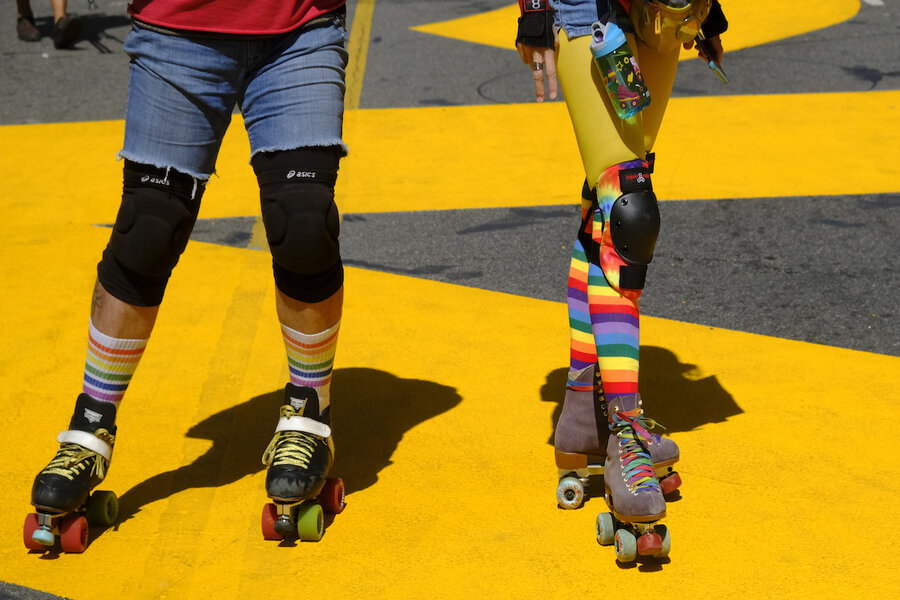Retro revival: Roller skating trend renews old sidewalk joys
Loading...
At a nondescript basketball court in Waltham, Massachusetts, the leaves take on an autumnal glow and the air is crisp. But there are no pickup basketball players. This is now a spot for people who roller skate.
“I had my eye on skates for a while – I saw they were making a comeback,” said Tammy Donroe Inman of Waltham, Massachusetts, who recently bought a pair of sparkly Impalas. She comes here every few days, turns on music, and skates.
“As an older skater, I thought I was going to be self-conscious, but I’m not,” she said, wearing a helmet and knee pads. “I fall all the time but it’s pure joy.”
With its retro flair, roller skating has been enjoying a 2020s revival and shows no signs of receding.
That may be partly due to the pandemic, which drew more people to an accessible, social, and physical activity that can be done outdoors. It’s also part of a larger fashion and music throwback to the disco era of the ’70s and ’80s, the last time roller skating was so hot. In the 1990s, inline skates, a kind of roller skate, were all the rage, but their buzz had gotten quieter.
Now, there are roller skating pop-up rinks in parks and on roadways, and lots and lots of skates on social media. Skate meet-ups in large cities are common – outside the Louvre Museum in Paris, for instance, or in Venice Beach, California, where skaters have congregated for decades.
New York City’s Rockefeller Center hosted a roller rink this summer for the first time since 1940, advertising that it was “bringing the magic of the 1970s with it.”
And then there are all the celebrities on skates.
Country star Tyler Hubbard does laps under a disco ball in a video to the new song “Baby Gets Her Lovin.’” Madonna took a spin around a popup rink in New York’s Central Park at a disco celebration this summer.
R&B singer Usher’s smooth skating videos pull in the views on TikTok and YouTube, while Joanna Gaines wore skates on the summer edition of her Magnolia magazine. Actors Ryan Gosling and Margot Robbie cruise up and down Venice Beach in neon-yellow inline skates as Ken and Barbie in next summer’s “Barbie” movie.
The filmmakers behind a 2019 HBO documentary, “United Skates,” about roller skating as a vibrant Black subculture, told The Associated Press then that they expected to be chronicling the end of an era. But they found the opposite. As one young Black skater told them, “Skating’s not dead. It just went underground.”
At Harlick Skates, a San Carlos, California-based skate-boot company started in 1933, fourth-generation owner Jason Kuhn said roller skate sales started to take off again in 2020.
“I started seeing the orders roll in,” he said archly.
While roller skates used to be only 20% of Harlick’s business, they’re now more popular than ice skates. “It was hard to find workers. Not everyone knows how to do this kind of work,” he said.
Many adult roller skaters haven’t skated since they were children. This has sparked a boom in online classes.
Nicole Fiore of Orange County, California, teaches skills and choreography classes online and on YouTube. Her parents worked as roller skating instructors, and she’s a four-time roller skating World Champion. She often missed school growing up because she was at competitions.
“I’ve never seen people roller skating in grocery store parking lots before, and suddenly they’re here,” she said. “I’ve been waiting for this moment my entire life.”
A day of skating can be a killer workout. There are varied forms of roller skating, including competitive, speed, dancing, and roller derby, a contact sport played between two teams.
Yet you don’t need to be in top shape to start roller skating.
Dana Johnson, whose roller derby name is Val Kyrie, started participating in a local league seven years ago after getting a divorce. She picked up roller derby after seeing a match, even though she didn’t consider herself athletic.
Ms. Kyrie of Minneapolis, is an engineer who now does public relations on the side for the Minnesota Roller Derby.
“Those skates are a great equalizer,” she said. “It’s all about how you use your body on those skates.”
There are, of course, roller-skating influencers. Across all social-media platforms, you can find people posting roller-skating videos, tutorials, and pretty pictures of skates.
Thirty-one-year-old Ana Coto lives in Los Angeles and goes by the social media handle @anaocto, an homage to the eight wheels on a roller skate. A 2020 TikTok video of her skating effortlessly to the Jennifer Lopez hit “Jenny From the Block” garnered 2.5 million likes and millions of views.
“There was no intention – just to feel good and feel happy, not to find something to put on TikTok,” she said. “I started posting a skate journal, really for myself.”
Then Ms. Coto saw that people were interested in watching her skate. An actress, she was contacted for appearances in a movie and has since appeared in the Dua Lipa music video “Levitating.”
“It is funny. Skating has given me this little foothold in the industry that I never had before,” she said.
This story was reported by The Associated Press.





